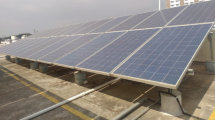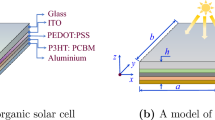Abstract
Structural Health Monitoring (SHM) based on electromechanical impedance (EMI) has been widely used in different engineering domains for the detection of structural damages, especially for detecting cracks that happen due to multiple reasons such as various natural conditions and operating cycles. However, studies of SHM based on EMI technique for the detection of faults in photovoltaic (PV) solar cells are very limited. This study aims to develop and integrate the EMI technique as a permanent monitoring system, to detect structural faults in advance, to maintain the PV system’s effectiveness and to ensure safety from catastrophic accidents. This work presents a numerical analysis of different models, such as free piezoelectric PZT patches of various shapes and several scenarios for healthy and cracked solar cells in order to investigate the capabilities of this technique. The crack is highlighted as a common damage in PV solar cells, and two of its characteristics were investigated namely, the crack location and the crack depth, where both are simulated with a pseudo-square monocrystalline solar cell. In addition, the root mean square deviation damage index is used to assess the severity of the damage. The results indicate that the damage index frequently changes with the variation in location and depth of the crack. Indeed, the proposed EMI technique can efficiently estimate the damage and its severity, which makes it possible to integrate it as a permanent detection and monitoring technique in a PV system.
















Similar content being viewed by others
References
Abid, M., et al.: Prospects of floating photovoltaic technology and its implementation in Central and South Asian Countries. Int. J. Environ. Sci. Technol. 16(3), 1755–1762 (2019)
Al-Soeidat, M., et al.: Experimental study of static and dynamic behaviours of cracked PV panels. IET Renew. Power Gener. 13(16), 3002–3008 (2019)
Amalu, E.H., et al.: Thermo-mechanical deformation degradation of crystalline silicon photovoltaic (c-Si PV) module in operation. Eng. Fail. Anal. 84, 229–246 (2018)
Schneller, E. J., et al.: Evaluating solar cell fracture as a function of module mechanical loading conditions. Proc. 44th IEEE, (2017)
Beinert, A. J., et al.: Influence of photovoltaic module mounting systems on the thermo-mechanical stresses in solar cells by FEM modelling. In Proc. of the 32nd European Photovoltaic Solar Energy Conference and Exhibition. (2016)
Pei, T.; Hao, X.: A fault detection method for photovoltaic systems based on voltage and current observation and evaluation. Energies 12(9), 1712 (2019)
Dhoke, A.; Sharma, R.; Saha, T.K.: An approach for fault detection and location in solar PV systems. Sol. Energy 194, 197–208 (2019)
Corrado, M.; Infuso, A.; Paggi, M.: Simulated hail impacts on flexible photovoltaic laminates: testing and modelling. Meccanica 52, 1425–1439 (2017)
Mathiak, G., et al.: PV Module Damages 1058 Caused by hail impact and non-uniform snow load, in 32nd European Photovoltaic Solar 1059 Energy Conference and Exhibition, p. 1692–1696. Munich, Germany (2016)
Gupta, V., et al.: Impact of hailstorm on the performance of PV module: a review. Energy Sources, Part A: Recovery, Utilization, and Environmental Effects, p. 1–22. (2019)
Mathiak, G., et al.: PV module damages caused By hail impact - field experience and lab tests, 31st European photovoltaic solar energy conference and exhibition, p. 1915–1919. Hamburg, Germany (2015)
Park, J.-J.; Park, C.-Y.; Ryu, J.-W.: Hail impact analysis of photovoltaic module using IEC test. J. Korean Solar Energy Soc. 40, 23–33 (2020)
Muehleisen, W., et al.: Outdoor detection and visualization of hailstorm damages of photovoltaic plants. Renew. Energy 118, 138–145 (2018)
Madeti, S.R.; Singh, S.N.: A comprehensive study on different types of faults and detection techniques for solar photovoltaic system. Sol. Energy 158, 161–185 (2017)
de Souza Rabelo, D., et al.: Real-time structural health monitoring of fatigue crack on aluminum beam using an impedance-based portable device. J. Intell. Mater. Syst. Struct. 28(20), 3152–3162 (2017)
Zhu, J., et al.: Electromechanical impedance-based damage localization with novel signatures extraction methodology and modified probability-weighted algorithm. Mech. Syst. Signal Process. 146, 107001 (2021)
Wang, T., et al.: Piezoelectric electro-mechanical impedance (EMI) based structural crack monitoring. Appl. Sci. 10(13), 4648 (2020)
Wang, T., et al.: Structural stress monitoring based on piezoelectric impedance frequency shift. J. Aerosp. Eng. 31(6), 04018092 (2018)
Bharathi Priya, C., et al.: EMI based monitoring of early-age characteristics of concrete and comparison of serial/parallel multi-sensing technique. Constr. Build. Mater. 191, 1268–1284 (2018)
Ai, D., et al.: Mechanical impedance based embedded piezoelectric transducer for reinforced concrete structural impact damage detection: a comparative study. Constr. Build. Mater. 165, 472–483 (2018)
Wang, F., et al.: A novel fractal contact-electromechanical impedance model for quantitative monitoring of bolted joint looseness. IEEE Access 6, 40212–40220 (2018)
Sun, R.; Sevillano, E.; Perera, R.: Identification of intermediate debonding damage in FRP-strengthened RC beams based on a multi-objective updating approach and PZT sensors. Compos. B Eng. 109, 248–258 (2017)
Qin, F., et al.: Experimental study on damage detection in ECC-concrete composite beams using piezoelectric transducers. Sensors 19(12), 2799 (2019)
Al-Adnani, N.N.A., et al.: Structural health monitoring and damage identification for composite panels using smart sensor. J. Intell. Mater. Syst. Struct. 27(17), 2313–2323 (2016)
Silva de Freitas, E.; Guimarães Baptista, F.: Experimental analysis of the feasibility of low-cost piezoelectric diaphragms in impedance-based SHM applications. Sens. Actuators A: Phys. 238, 220–228 (2016)
Moharana, S.; Bhalla, S.: Numerical investigations of shear lag effect on PZT-structure interaction: review and application. Curr. Sci. (Bangalore) 103(6), 685–696 (2012)
Su, Y.-F., et al.: Instantaneous monitoring the early age properties of cementitious materials using PZT-based electromechanical impedance (EMI) technique. Constr. Build. Mater. 225, 340–347 (2019)
Zhu, J.; Wang, Y.; Qing, X.: A real-time electromechanical impedance-based active monitoring for composite patch bonded repair structure. Compos. Struct. 212, 513–523 (2019)
Yang, Y.; Hu, Y.: Electromechanical impedance modeling of PZT transducers for health monitoring of cylindrical shell structures. Smart Mater. Struct. 17(1), 015005 (2007)
de Souza Rabelo, D., et al.: Impedance-based structural health monitoring and statistical method for threshold-level determination applied to 2024–T3 aluminum panels under varying temperature. Struct. Health Monit. 16(4), 365–381 (2017)
Gresil, M., et al.: Predictive modeling of electromechanical impedance spectroscopy for composite materials. Struct. Health Monit. 11(6), 671–683 (2012)
Adhikari, S.; Bhalla, S.: Modified dual piezo configuration for improved structural health monitoring using electro-mechanical impedance (EMI) technique. Exp. Tech. 43(1), 25–40 (2019)
Kim, H., et al.: Performance assessment method for crack repair in concrete using PZT-based electromechanical impedance technique. NDT and E Int. 104, 90–97 (2019)
Djemana, M.; Hrairi, M.: Modelling and simulation of impedance-based damage monitoring of structures. Int. J. Simul. Model. 15(3), 295–408 (2016)
Meier, R., et al.: Reliability of copper-ribbons in photovoltaic modules under thermo-mechanical loading. In 2010 35th IEEE Photovoltaic Specialists Conference. (2010)
Syafiqah, Z., et al.: Thermal and electrical study for PV panel with cooling. Indones. J. Electr. Eng. Comput. Sci. 7(2), 492–499 (2017)
Hu, Y.; Yang, Y.: Wave propagation modeling of the PZT sensing region for structural health monitoring. Smart Mater. Struct. 16(3), 706 (2007)
Acknowledgements
This research was funded by a grant from the International Islamic University Malaysia Research Management Centre (grant number/project id: RMCG20-032-0032). The authors gratefully acknowledge assistance received from Mrs. Lynn Mason for editing this manuscript.
Author information
Authors and Affiliations
Corresponding author
Ethics declarations
Conflict of interest
The authors declare that they have no known competing financial interests or personal relationships that could have appeared to influence the work reported in this paper.
Rights and permissions
Springer Nature or its licensor (e.g. a society or other partner) holds exclusive rights to this article under a publishing agreement with the author(s) or other rightsholder(s); author self-archiving of the accepted manuscript version of this article is solely governed by the terms of such publishing agreement and applicable law.
About this article
Cite this article
Beroual, S., Hrairi, M. Electromechanical Impedance Simulation-Based Evaluation of Cracks in Photovoltaic Solar Cells. Arab J Sci Eng 48, 12313–12329 (2023). https://doi.org/10.1007/s13369-023-07733-9
Received:
Accepted:
Published:
Issue Date:
DOI: https://doi.org/10.1007/s13369-023-07733-9




